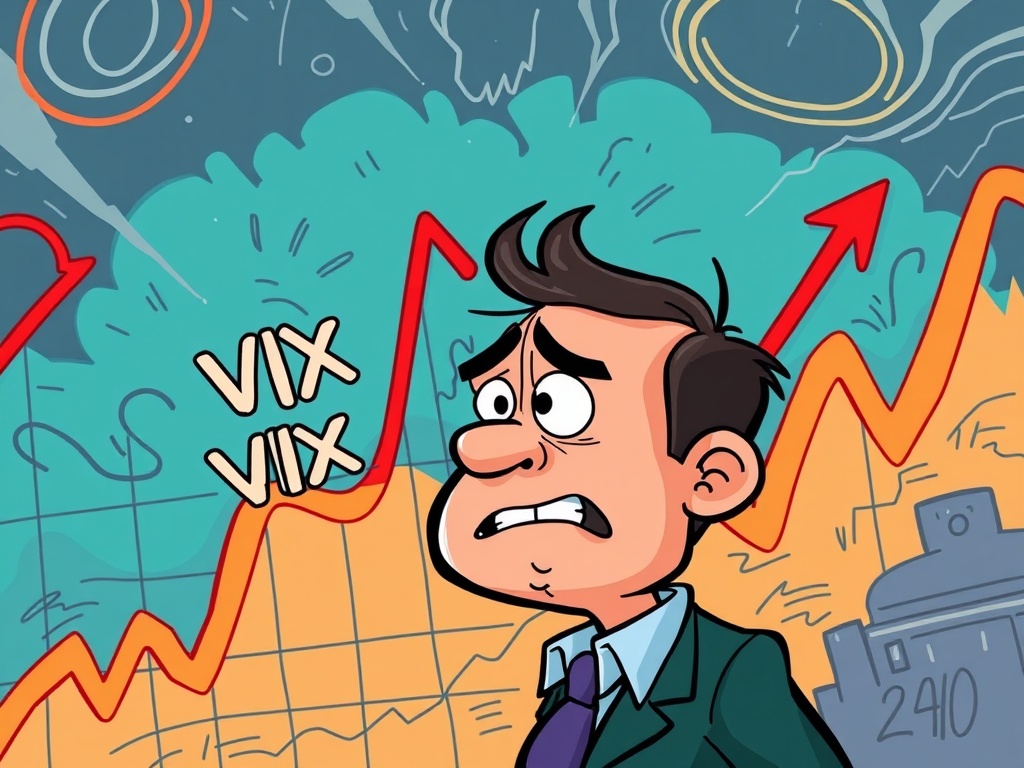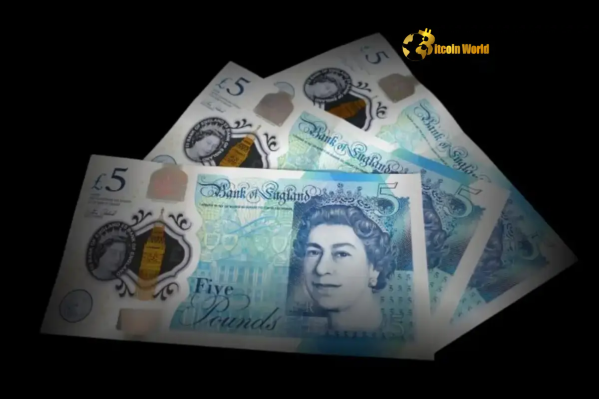BitcoinWorld

VIX Fear Gauge: Alarming Rise Above 20 Signals Market Jitters
In the often-unpredictable world of financial markets, certain indicators serve as crucial barometers of investor sentiment. One such prominent gauge is the Chicago Board Options Exchange Volatility Index, universally known as the VIX. Recently, the VIX fear gauge surged above the critical 20-point threshold for the first time since June, a development that has sent ripples across global markets and caught the attention of investors worldwide. This move is not just a number on a screen; it’s a powerful signal that often precedes periods of increased market uncertainty and volatility. Understanding what this means is key for any investor navigating today’s complex financial landscape, including those in the cryptocurrency space.
Understanding the VIX Fear Gauge: What Does It Measure?
The VIX fear gauge is often dubbed Wall Street’s ‘fear gauge’ because it aims to measure the market’s expectation of future volatility over the next 30 days. It does this by tracking the implied volatility of options on the S&P 500 Index (SPX). In simpler terms, it’s a forward-looking measure of how much the market expects stock prices to fluctuate.
- How it works: The VIX is derived from the prices of a wide range of S&P 500 options. When investors anticipate larger price swings, the demand for these options (especially out-of-the-money options) increases, driving up their prices. This, in turn, pushes the VIX higher.
- Inverse relationship: Typically, the VIX moves inversely to the stock market. When stocks fall, the VIX tends to rise, reflecting heightened fear and uncertainty. Conversely, when stocks are calm and rising, the VIX often remains low.
- A predictive tool: While not a perfect predictor, the VIX provides valuable insight into the collective anxiety or complacency of market participants. A rising VIX suggests that investors are bracing for potential turbulence.
Why is the VIX Fear Gauge Rising Above 20 Crucial?
The 20-point level on the VIX fear gauge is often considered a psychological and technical threshold. Historically:
- Below 20: Indicates a period of relative calm and stability in the market. Investors feel less uncertain, and price movements are generally more subdued.
- Above 20: Signals an increase in perceived risk and market uncertainty. This is where fear begins to creep into investor psychology, potentially leading to more erratic price swings and increased caution.
- Above 30: Suggests significant market stress, often associated with major sell-offs or economic crises.
The recent jump above 20, for the first time since June, indicates a notable shift in market sentiment. It suggests that underlying concerns, whether related to inflation, interest rates, geopolitical tensions, or other macroeconomic factors, are intensifying. This rise reflects a collective hedging against potential downside risks, as investors become more apprehensive about the near-term outlook for equities.
| VIX Level Range | Market Sentiment Indication | Typical Market Behavior |
|---|---|---|
| Below 20 | Calm, Low Volatility | Stable prices, gradual trends, investor complacency |
| 20 – 30 | Moderate Fear, Increased Uncertainty | Increased price swings, cautious trading, potential pullbacks |
| Above 30 | High Fear, Panic | Significant market turbulence, sharp declines, flight to safety |
Navigating Volatility: Actionable Insights for Investors When the VIX Fear Gauge Rises
A rising VIX fear gauge doesn’t necessarily mean a market crash is imminent, but it does signal a period where investors should exercise increased caution and strategic planning. Here are some actionable insights:
- Review Your Portfolio: High volatility periods are ideal for reassessing your risk tolerance and ensuring your portfolio allocation aligns with your long-term goals. Consider if you are overexposed to highly volatile assets.
- Diversify: Ensure your investments are well-diversified across different asset classes, industries, and geographies. Diversification can help mitigate losses during turbulent times, as not all assets move in lockstep.
- Consider Defensive Sectors: During periods of fear, traditionally defensive sectors like consumer staples, utilities, and healthcare tend to perform better as their earnings are less sensitive to economic cycles.
- Dollar-Cost Averaging: If you are a long-term investor, consider maintaining a strategy of dollar-cost averaging. This involves investing a fixed amount regularly, regardless of market fluctuations. This way, you buy more shares when prices are low and fewer when prices are high, averaging out your cost over time.
- Maintain Cash Reserves: Having some cash on hand can provide liquidity and the flexibility to seize opportunities when assets become undervalued during market downturns.
- Avoid Panic Selling: Emotional decisions, especially during fearful periods, often lead to selling at the bottom. Stick to your investment plan and avoid making impulsive moves based on short-term market noise.
- Focus on Quality: Invest in companies with strong fundamentals, healthy balance sheets, and proven business models that can weather economic storms.
The Cryptocurrency Connection: How VIX Fear Gauge Movements Impact Digital Assets
While cryptocurrencies like Bitcoin and Ethereum were once touted as uncorrelated assets, immune to traditional market movements, the reality has shifted. As institutional adoption has grown and digital assets have become more integrated into the broader financial system, their correlation with traditional markets, especially during periods of stress, has increased. Therefore, the rise in the VIX fear gauge can certainly have implications for crypto investors.
- Risk-Off Sentiment: When the VIX rises, indicating a ‘risk-off’ sentiment in traditional markets, investors often pull money from riskier assets. Cryptocurrencies, despite their unique characteristics, are still largely perceived as high-risk assets by many institutional and retail investors.
- Liquidation Events: Increased volatility in traditional markets can sometimes lead to margin calls or liquidity issues for investors who hold both traditional and crypto assets, potentially forcing them to sell crypto to cover losses elsewhere.
- Macroeconomic Factors: The underlying macroeconomic concerns that drive the VIX higher (e.g., inflation, interest rate hikes, economic slowdowns) also directly impact investor appetite for speculative assets like cryptocurrencies. When interest rates rise, the appeal of non-yielding assets like crypto can diminish.
- Short-Term Volatility: Just as traditional markets experience increased swings when the VIX is high, crypto markets can also see heightened short-term volatility, making them even more unpredictable.
However, it’s important to note that the correlation is not always perfect or sustained. Cryptocurrencies still have their own unique drivers, such as technological developments, regulatory news, and network adoption. Yet, ignoring the signals from the VIX in a broader market context would be a mistake for any crypto investor seeking a comprehensive understanding of market dynamics.
The recent ascent of the VIX fear gauge above 20 serves as a powerful reminder that financial markets are dynamic and constantly influenced by investor sentiment. While it signals heightened caution and potential turbulence, it also presents an opportunity for informed investors to review their strategies, manage risk effectively, and position themselves for the long term. By understanding what the VIX signifies and its potential ripple effects across various asset classes, including cryptocurrencies, investors can make more rational decisions and navigate the challenging waters of market volatility with greater confidence.
Frequently Asked Questions (FAQs)
What does the VIX index measure?
The VIX index measures the market’s expectation of future volatility in the S&P 500 Index over the next 30 days. It is often referred to as Wall Street’s ‘fear gauge’ because it tends to rise when investors anticipate increased market uncertainty.
Why is 20 a significant level for the VIX?
The 20-point level on the VIX is considered a key threshold. A VIX below 20 generally indicates a calm market with low perceived risk, while a VIX above 20 signals increased market uncertainty and potential for larger price swings, reflecting growing investor fear.
How does a high VIX impact stock markets?
A high VIX suggests that investors are bracing for increased volatility. This can lead to more erratic price movements, potential market pullbacks, and a general ‘risk-off’ sentiment where investors may move away from riskier assets towards safer havens.
Is the VIX relevant for cryptocurrency investors?
Yes, increasingly so. While cryptocurrencies were once seen as uncorrelated, their growing integration into the broader financial system means they are often affected by the same macroeconomic factors and ‘risk-off’ sentiment that drive the VIX, especially during periods of high market stress.
What actions should investors consider when the VIX is high?
When the VIX is high, investors should consider reviewing their portfolio diversification, maintaining adequate cash reserves, focusing on quality assets, and avoiding emotional decisions like panic selling. A long-term perspective and dollar-cost averaging can also be beneficial strategies.
Does a rising VIX always mean a market crash is coming?
Not necessarily. While a rising VIX indicates heightened fear and potential for turbulence, it is a measure of expected volatility, not a direct predictor of a market crash. It signals that investors are preparing for larger price swings, which could be up or down, but more often implies downside risk.
If you found this article insightful, consider sharing it with your friends, family, and network on social media. Your shares help us continue to provide valuable market insights and analysis to a wider audience!
To learn more about the latest crypto market trends, explore our article on key developments shaping Bitcoin price market.
This post VIX Fear Gauge: Alarming Rise Above 20 Signals Market Jitters first appeared on BitcoinWorld and is written by Editorial Team





